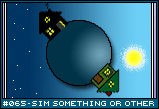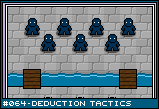| Three Hundred |
| - Index Page |
| - About... |
| - By Year |
| Collections |
| - Comp-Grid |
| - Procedural |
| - Tactics |
| - Tiny Crawl |
| - Misc |
| Previous | Mechanic #065 | Next |
This idea is related to the previous one, [#064 - Deduction Tactics] - or rather, I should say was the basis of that idea. Similar to Deduction Tactics, this game presents you with a group of unknown quantities and charges you with figuring what the big question marks are. Unlike Deduction Tactics, this is more of a puzzle game. ![[something1.png]](set04/img/entry065-something1.png) Initially, you are presented with an abstract representation of some unknown system. It operates in real time and you can watch it happen - you just lack the metaphor which makes it make sense. It's a simulation of something, and it's up to you to figure out what. In this case, you are presented with five unknowns of various sizes (the background is considered an unknown). The smallest light block simply rotates around the other three. From looking at this, it is not immediately obvious what it is. However, you are also presented with a bunch of sim elements that you can attribute to each unknown. ![[something2.png]](set04/img/entry065-something2.png) After attributing the correct elements to each unknown, you realize that it is a sunset simulator. The sun rotates around a planet, lighting it appropriately. The houses themselves react to the light, switching between darkened and lightened. Setting the background to a sky will cause stars to either come out or be obscured by the sun's light. Once you've figured it out, you can watch the little simulation in action, as the sun rotates around the planet and the houses and stars adjust accordingly.
Each potential object has various states, inputs, and outputs. Each object may affect every other object in the scene in some way such that by replacing the sun with a hot dog, you might arrive at a very different simulation - something which doesn't quite make sense though. Sun - The sun takes no input, though it is manipulated by the current puzzle to spin around the center mass. It simply outputs a radial light source that other objects may pick up and do something with. Planet - The planet doesn't really do anything one way or another, though it does properly light itself when presented with a light source or two. House - The house is a simple two-state object. If it is receiving X amount of light (dictated by the distance from the radial light source, or the addition of several light sources if needed) then it is in "daytime mode". In the absence of light, it is in "nighttime mode". Sky - The sky is simply a sea of stars. However, a strong enough light source will change the color from dark blue to light blue and the stars won't show through. With a radial light source, how blue the sky is and how many stars shine is related to distance from the center of the light source. Ultimately, there would be many puzzles and potentially hundreds of objects that one could apply to scene. You could apply any of them (for instance, a hot dog instead of a sun gives off no light, so the houses would always be dark and the sky always starry), but only one combination would make sense. To help thing along, I think that, as I have in the initial illustration, objects should have a size (4x4, 2x2, 1x1, etc) that would help limit options and keep things a little more streamlined.
The purpose of this idea is to more or less exposure the difference between gameplay and the metaphor that gameplay uses to convey itself. Ultimately, as far as the computer is concerned, it really is just staring at a bunch of shapeless objects with various states and input conditions. We humans have issues assimilating information that way, but we can absorb all that and more by putting it into a familiar context. The trick is how we take the formless and give it form, isn't it?
|


